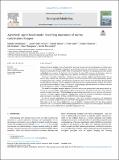Files in this item
AgentSeal : agent-based model describing movement of marine central-place foragers
Item metadata
| dc.contributor.author | Chudzinska, Magda | |
| dc.contributor.author | Nabe-Nielsen, Jacob | |
| dc.contributor.author | Smout, Sophie | |
| dc.contributor.author | Aarts, Geert | |
| dc.contributor.author | Brasseur, Sophie | |
| dc.contributor.author | Graham, Isla | |
| dc.contributor.author | Thompson, Paul | |
| dc.contributor.author | McConnell, Bernie | |
| dc.date.accessioned | 2020-12-30T07:30:15Z | |
| dc.date.available | 2020-12-30T07:30:15Z | |
| dc.date.issued | 2021-01-15 | |
| dc.identifier | 271870326 | |
| dc.identifier | 2c437db4-986f-4cfc-918e-00b2e2f5de8f | |
| dc.identifier | 85098461628 | |
| dc.identifier | 000612041200002 | |
| dc.identifier.citation | Chudzinska , M , Nabe-Nielsen , J , Smout , S , Aarts , G , Brasseur , S , Graham , I , Thompson , P & McConnell , B 2021 , ' AgentSeal : agent-based model describing movement of marine central-place foragers ' , Ecological Modelling , vol. 440 , 109397 . https://doi.org/10.1016/j.ecolmodel.2020.109397 | en |
| dc.identifier.issn | 0304-3800 | |
| dc.identifier.other | RIS: urn:81C18C91E291C1E297BADCB9F2B2D9E4 | |
| dc.identifier.other | ORCID: /0000-0001-7575-5270/work/86140843 | |
| dc.identifier.other | ORCID: /0000-0001-9568-1504/work/86141065 | |
| dc.identifier.uri | https://hdl.handle.net/10023/21210 | |
| dc.description | This project has received funding from the European Union's Horizon 2020 research and innovation programme under the Marie Skłodowska-Curie grant agreement No 746602. GA and SB have been partly funded by Gemini Wind park and the NWO (project ALWPP.2017.003). | en |
| dc.description.abstract | Understanding why animals move as they do when searching for resources is a central question in ecology, and a prerequisite for the development of predictive process-based models for conservation and management. Many species are central-place foragers (CPF). While several models for CPFs have been proposed, they often assume well-defined return rules to the focal point (like breeding). For some CPFs, however, the decisions to return to central sites are governed by multiple interactions between environmental and physiological factors. We present AgentSeal, a behaviour- and physiology-based, spatially explicit, agent-based model. We use harbour seals, a marine CPF, as a case study and focus on individuals outside their breeding and moulting seasons to capture general fine- and large-scale movements and drivers behind CPF. We model movement decisions based on optimal foraging strategy, cognitive and physiological processes in a realistic landscape, coupled with realistic prey distribution and tuned to a range of behavioural and physiological patterns observed at different scales and levels of organisation (pattern-orientated modelling, POM). The model can reproduce energetic, movement and other behavioural patterns such as net energy balance, at-sea and on land site fidelity, daily activity budgets and trip extents. The model reveals the crucial elements needed to model return-trips of CPFs including movement characteristics that vary as a function of local environmental conditions, cognitive mapping of foraging areas as points of attraction in subsequent foraging trips, and physiological requirements defining switches between resting and foraging. We discuss potential applications and extensions of the model, including investigations of fundamental questions in foraging ecology: how spatial distribution and aggregation of resources affect movement of marine CPFs; what are the main drivers behind their at-sea site-fidelity to foraging patches? We also discuss applied objectives such as improving our understanding of population-level consequences of anthropogenic disturbances and ultimately evolving AgentSeal into a practical management tool. | |
| dc.format.extent | 1774351 | |
| dc.language.iso | eng | |
| dc.relation.ispartof | Ecological Modelling | en |
| dc.subject | Optimal foraging | en |
| dc.subject | Marine central-place foragers | en |
| dc.subject | Process-based modelling | en |
| dc.subject | Harbour seals | en |
| dc.subject | QH301 Biology | en |
| dc.subject | DAS | en |
| dc.subject | SDG 14 - Life Below Water | en |
| dc.subject.lcc | QH301 | en |
| dc.title | AgentSeal : agent-based model describing movement of marine central-place foragers | en |
| dc.type | Journal article | en |
| dc.contributor.sponsor | European Commission | en |
| dc.contributor.institution | University of St Andrews. School of Biology | en |
| dc.contributor.institution | University of St Andrews. Sea Mammal Research Unit | en |
| dc.contributor.institution | University of St Andrews. Scottish Oceans Institute | en |
| dc.contributor.institution | University of St Andrews. Centre for Research into Ecological & Environmental Modelling | en |
| dc.contributor.institution | University of St Andrews. Coastal Resources Management Group | en |
| dc.contributor.institution | University of St Andrews. Marine Alliance for Science & Technology Scotland | en |
| dc.identifier.doi | 10.1016/j.ecolmodel.2020.109397 | |
| dc.description.status | Peer reviewed | en |
| dc.identifier.url | https://www.sciencedirect.com/science/article/pii/S0304380020304610?via%3Dihub#sec0029 | en |
| dc.identifier.grantnumber | 746602 | en |
This item appears in the following Collection(s)
Items in the St Andrews Research Repository are protected by copyright, with all rights reserved, unless otherwise indicated.

